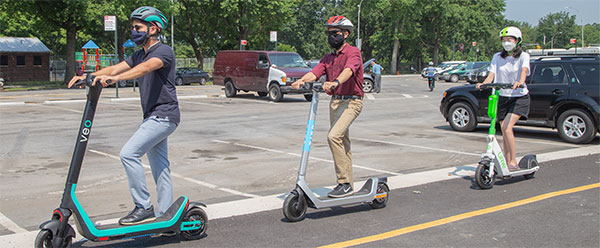
E-Scooters (photo: NYC DOT)
There’s a revolution going on in the streets of American cities. And it’s driving lots of people crazy.
From coast to coast, in cities large and small, we’re seeing an explosion of new types of electric-powered vehicles. There are e-bikes, of course, including cargo bikes. But there are also electric scooters, electric mopeds, electric skateboards, even electric unicycles. All of these micromobility devices — so called because they are smaller than the humans riding them — represent an exciting new frontier in urban transportation. There are more new vehicles coming to the streets near you very soon, including a variety of electric cargo-delivery bikes and even small, low-speed autonomous vehicles that could be used as taxis or for deliveries.
Clean, quiet, and lightweight, these innovations provide individual users and businesses with the flexibility and freedom of a personal vehicle without subjecting everybody else to the noise and fumes of internal combustion engines. They will be instrumental in meeting the carbon-reduction goals we will all need to embrace in coming years. They also put a lot less wear and tear on our streets and combine easily with public transit, gracefully solving the “last mile problem” that persists in communities around the country.
The only issue is that we don’t really have anywhere for them to go.
E-scooters, e-skateboards, and the like shouldn’t be on sidewalks, where they inconvenience and endanger pedestrians. They also shouldn’t be jockeying for position with trucks, buses, SUVs, and cars in conventional traffic lanes, where their operators are at risk of injury or even death. The obvious place for them to operate is bike lanes — except that the bike lanes we have are too narrow, too unprotected, and too fragmented to make a real transportation network. People who ride traditional bikes are understandably skeptical and nervous about sharing the scant resources they have with vehicles that have electric motors and can travel at higher speeds.
There’s an opportunity here, however, for cities and vehicle manufacturers to partner in creating new facilities that would accommodate a host of small, nimble vehicles, both innovative and traditional. Let’s call them New Mobility Lanes.
New Mobility Lanes would be expanded and enhanced versions of existing bike lanes, designed to accommodate multiple types of relatively slow (10 to 15 miles per hour), lightweight vehicles, including conventional bicycles. Such lanes would be 10 or 11 feet wide, ample to permit safe passing, and protected by physical barriers from incursions by prohibited vehicles. They should extend throughout the city in a robust network that takes users where they want and need to go.
In order for these new lanes to be safe and pleasant for a wide range of users, the types of vehicles that can enter should be regulated. Cities could require limits on heights, weights, and widths; safety features to reduce the risk of collisions with cyclists and pedestrians; and automated data feeds that would monitor and fine illegal maneuvers. Most importantly, so that e-vehicles mix well with conventional bikes, local authorities could mandate speed regulators to ensure that vehicles with electric motors never go faster than, say, 10 to 15 miles per hour. (That limit might frustrate individual users, but any faster would be unsafe in this context, and the resulting order would pay off for everyone in the end.) Geofencing could prevent e-vehicles from driving on the sidewalk. Cities could also determine how much noise such vehicles could make, and require them to be zero-emission.
By expanding the capacity of what have been simply “bike lanes” up until now and building out comprehensive networks of New Mobility Lanes, cities could enlist new constituencies in advocating for their implementation. Drivers understand that trucks are a significant aspect of congestion, so the prospect of moving cargo into small vehicles in a separate lane may appeal to them. Although e-scooters are too new to offer really good data, there is evidence from other cities that they replace car and taxi trips more than they replace cycling trips, suggesting they may draw in yet more users for the new lanes. And the prospect of enclosed, powered, slow-speed vehicles in those lanes could expand their appeal to include many who would never consider themselves cyclists.
In fact, the biggest value of New Mobility Lanes might actually be that they would create a template for the new class of autonomous vehicles that is already coming into being. If AVs are designed to operate on regular streets, cities will have little control over them. But building a widespread network of low-speed lanes with strict specifications on what kind of vehicles can use them would incentivize AV manufacturers to conform to those standards. The result would be mobility innovations that are designed for steady, slow movement rather than speeding and stopping — human-friendly vehicles built to move with the city, not against it.
***
Rohit T. Aggarwala is senior urban tech fellow at Cornell Tech’s Urban Tech Hub. On Twitter @Rit_Aggarwala.
***
Have an op-ed idea or submission for Gotham Gazette? Email This email address is being protected from spambots. You need JavaScript enabled to view it.




